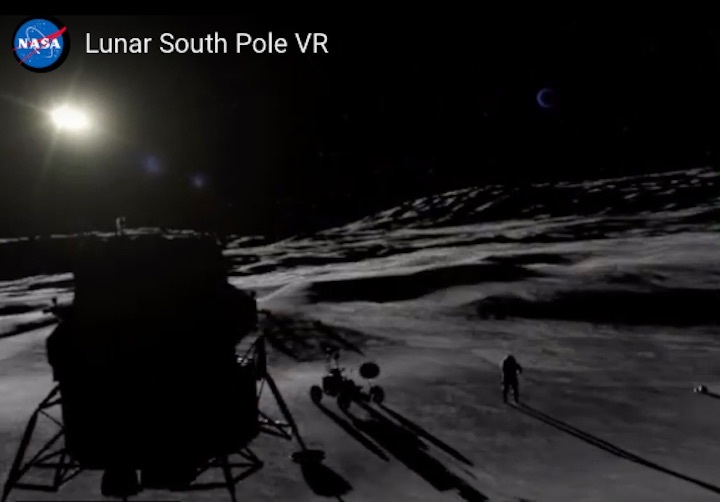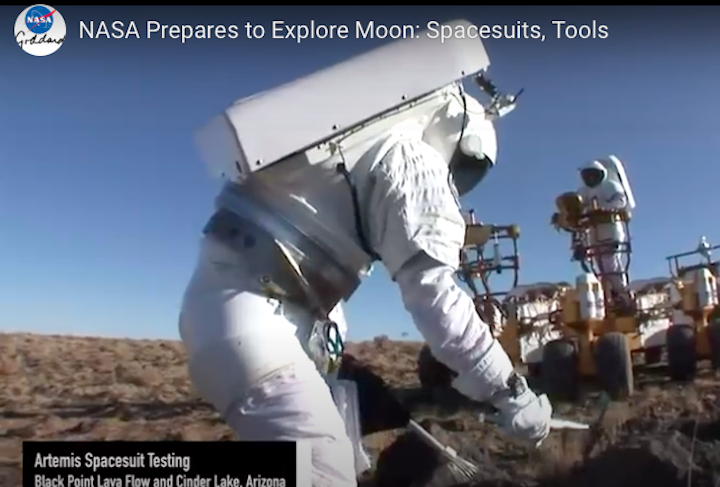1.02.2021
American astronauts in 2024 will take their first steps near the Moon’s South Pole: the land of extreme light, extreme darkness, and frozen water that could fuel NASA’s Artemis lunar base and the agency’s leap into deep space.
Scientists and engineers are helping NASA determine the precise location of the Artemis Base Camp concept. Among the many things NASA must take into account in choosing a specific location are two key features: The site must bask in near continuous sunlight to power the base and moderate extreme temperature swings, and it must offer easy access to areas of complete darkness that hold water ice.
While the South Pole region has many well-illuminated areas, some parts see more or less light than others. Scientists have found that at some higher elevations, such as on crater rims, astronauts would see longer periods of light. But the bottoms of some deep craters are shrouded in near constant darkness, since sunlight at the South Pole strikes at such a low angle it only brushes their rims.
These unique lighting conditions have to do with the Moon’s tilt and with the topography of the South Pole region. Unlike Earth’s 23.5-degree tilt, the Moon is tilted only 1.5 degrees on its axis. As a result, neither of the Moon’s hemispheres tips noticeably toward or away from the Sun throughout the year as it does on Earth — a phenomenon that gives us sunnier and darker seasons here. This also means that the height of the Sun in the sky at the lunar poles doesn’t change much during the day. If a person were standing on a hilltop near the lunar South Pole during daylight hours, at any time of year, they would see the Sun moving across the horizon, skimming the surface like a flashlight laying on a table.
A clip from a virtual reality tour of the Moon’s South Pole created by NASA engineers to help immerse astronauts, scientists, and mission planners in the exotic environment of that region as they prepare for a human return to the Moon.

Credits: NASA's Goddard Space Flight Center/Jeffrey Hosler/W. Brent Garry/Thomas G. Grubb
“It’s such a dramatic terrain down there,” said W. Brent Garry, a geologist at NASA’s Goddard Space Flight Center in Greenbelt, Maryland. Garry is working with engineers on a virtual reality tour of the Moon’s South Pole to help immerse astronauts, scientists, and mission planners in the exotic environment of that region as they prepare for a human return to the Moon.
While a base camp site will require lots of light, it is also important for astronauts to be able to take short trips into permanently dark craters. Scientists expect that these shadowed craters are home to reservoirs of frozen water that explorers could use for life support. “One idea is to set up camp in an illuminated zone and traverse into these craters, which are exceptionally cold,” said NASA Goddard planetary scientist Daniel P. Moriarty, who’s involved with NASA’s South Pole site analysis and planning team. Temperatures in some of the coldest craters can dip to about -391 degrees Fahrenheit (-235 degrees Celsius).
Initial plans include landing a spacecraft on a relatively flat part of a well-lit crater rim or a ridge. “You want to land in the flattest area possible, since you don’t want the landing vehicle to tip over,” Moriarty said.
The landing area, ideally, should be separated from other base camp features — such as the habitat or solar panels — by at least half a mile, or 1 kilometer. It also ought to be situated at a different elevation to prevent descending spacecraft from spraying high-speed debris at equipment or areas of scientific interest. Some scientists have estimated that as a spacecraft thrusts its engines for a soft landing, it could potentially spray hundreds of pounds, or kilograms, of surface particles, water, and other gases across a couple of miles, or several kilometers.
“You want to take advantage of the landforms, such as hills, that can act as barriers to minimize the impact of contamination,” says Ruthan Lewis, a biomechanical and industrial engineer, architect, and a leader on NASA’s South Pole site analysis and planning team. “So, we’re looking at distances, elevations, and slopes in our planning.”
Preparing to explore the surface of the Moon goes well beyond designing and building safe spacecraft and spacesuits. NASA also has to ensure the surface vehicles and suits have the mobility required to do science, and that astronauts have the tools they need to identify and scoop up rock and soil samples.

Credits: NASA's Goddard Space Flight Center/James Tralie
At the Moon, it’s critical to keep the area around the landing site and base camp as pristine as possible for scientists. For instance, among the many interesting features of the South Pole region is its location right between the Earth-facing side of the Moon, or the near side, and the side we never see from Earth, known as the far side.
These two hemispheres are geologically very different, with the far side more heavily cratered and its crust thicker than on the near side. Scientists don’t know why the two sides formed this way.
The Artemis Base Camp has to be on the Earth-facing side to make it easier for engineers to use radio waves to communicate with astronauts working on the Moon. But scientists expect that over billions of years of meteorite impacts to the Moon’s surface, rocks, and dust from each hemisphere were kicked up and strewn about the other, so it’s possible that astronauts could collect samples of the far side from their base camp on the near side.
Quelle: NASA
